Analyzing Cross-Cultural Management Communication Strategies
VerifiedAdded on 2023/06/03
|5
|1105
|367
Essay
AI Summary
This essay delves into the complexities of cross-cultural management, focusing on effective communication strategies within global teams, particularly between a U.S. manager and representatives from Mexico and China. It highlights the challenges arising from differing cultural contexts, especially the contrast between the U.S.'s low-context communication style and the high-context cultures of Mexico and China, where non-verbal cues and personal relationships are paramount. The essay analyzes potential barriers and biases in cross-cultural business communications, such as misunderstandings during information exchange and differing values regarding relationships versus contracts. Furthermore, it proposes mitigation strategies for the U.S. manager, emphasizing the importance of building personal relationships, active listening, and respecting cultural nuances to foster effective communication and prevent misinterpretations. The essay concludes by underscoring the need for adaptability and cultural sensitivity in international business negotiations to ensure successful outcomes.
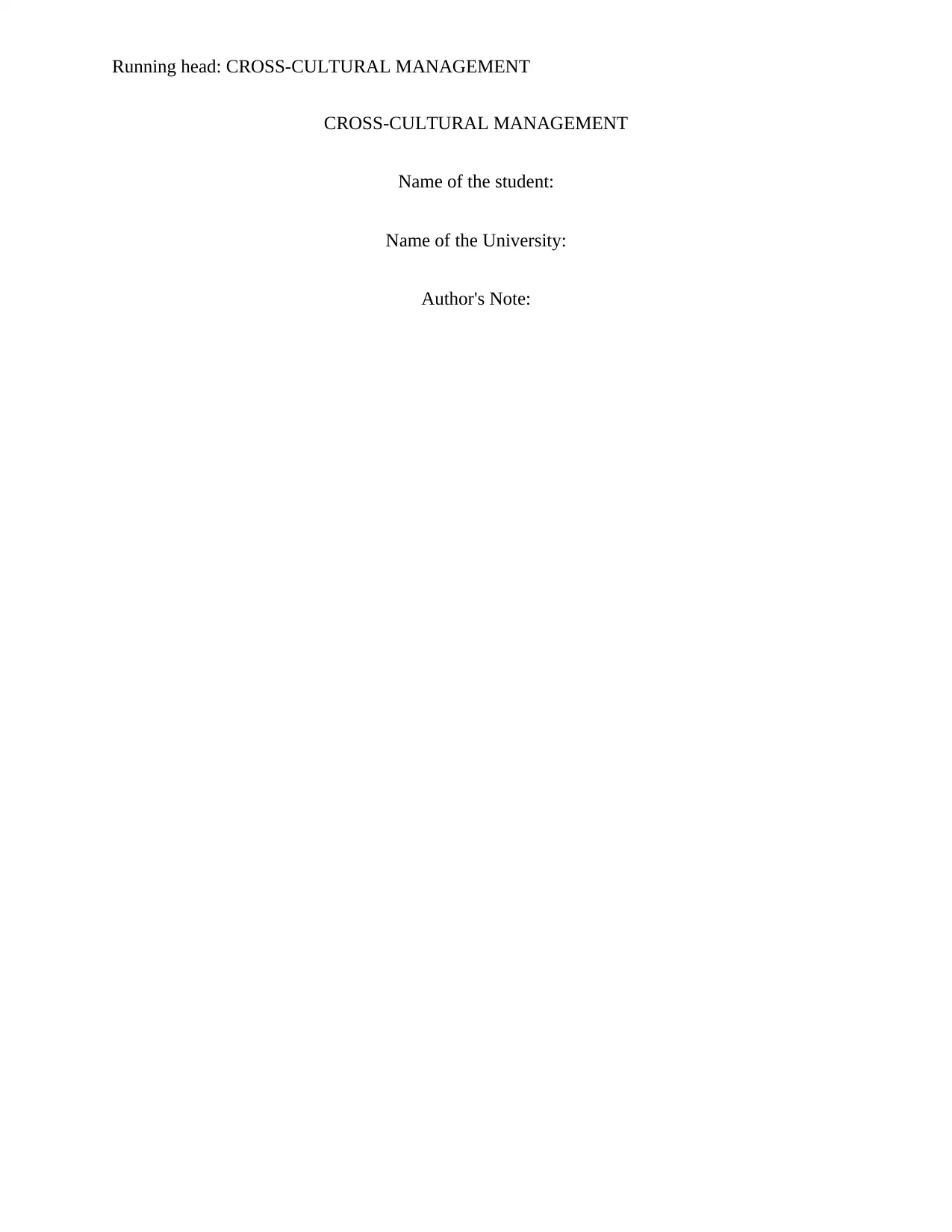
Running head: CROSS-CULTURAL MANAGEMENT
CROSS-CULTURAL MANAGEMENT
Name of the student:
Name of the University:
Author's Note:
CROSS-CULTURAL MANAGEMENT
Name of the student:
Name of the University:
Author's Note:
Paraphrase This Document
Need a fresh take? Get an instant paraphrase of this document with our AI Paraphraser
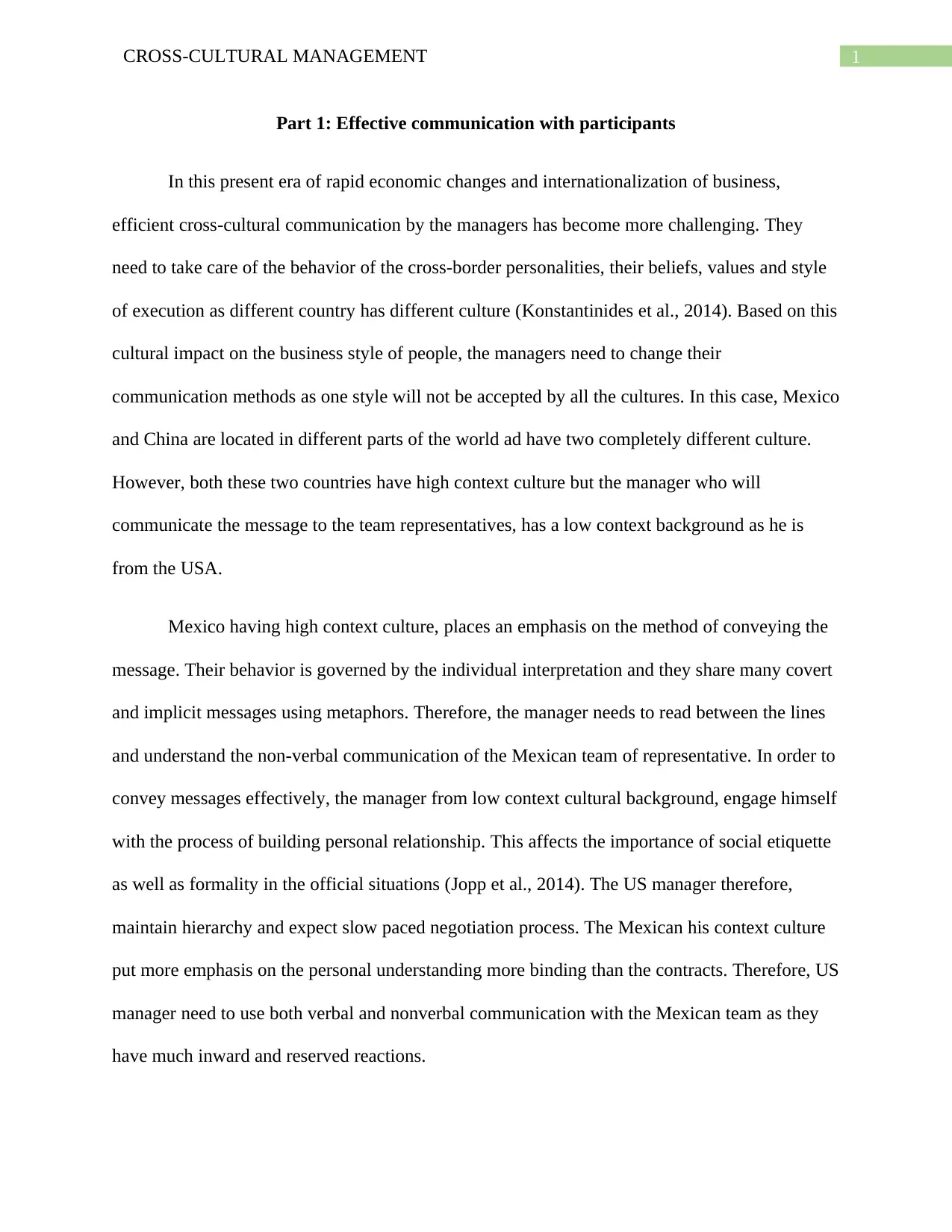
1CROSS-CULTURAL MANAGEMENT
Part 1: Effective communication with participants
In this present era of rapid economic changes and internationalization of business,
efficient cross-cultural communication by the managers has become more challenging. They
need to take care of the behavior of the cross-border personalities, their beliefs, values and style
of execution as different country has different culture (Konstantinides et al., 2014). Based on this
cultural impact on the business style of people, the managers need to change their
communication methods as one style will not be accepted by all the cultures. In this case, Mexico
and China are located in different parts of the world ad have two completely different culture.
However, both these two countries have high context culture but the manager who will
communicate the message to the team representatives, has a low context background as he is
from the USA.
Mexico having high context culture, places an emphasis on the method of conveying the
message. Their behavior is governed by the individual interpretation and they share many covert
and implicit messages using metaphors. Therefore, the manager needs to read between the lines
and understand the non-verbal communication of the Mexican team of representative. In order to
convey messages effectively, the manager from low context cultural background, engage himself
with the process of building personal relationship. This affects the importance of social etiquette
as well as formality in the official situations (Jopp et al., 2014). The US manager therefore,
maintain hierarchy and expect slow paced negotiation process. The Mexican his context culture
put more emphasis on the personal understanding more binding than the contracts. Therefore, US
manager need to use both verbal and nonverbal communication with the Mexican team as they
have much inward and reserved reactions.
Part 1: Effective communication with participants
In this present era of rapid economic changes and internationalization of business,
efficient cross-cultural communication by the managers has become more challenging. They
need to take care of the behavior of the cross-border personalities, their beliefs, values and style
of execution as different country has different culture (Konstantinides et al., 2014). Based on this
cultural impact on the business style of people, the managers need to change their
communication methods as one style will not be accepted by all the cultures. In this case, Mexico
and China are located in different parts of the world ad have two completely different culture.
However, both these two countries have high context culture but the manager who will
communicate the message to the team representatives, has a low context background as he is
from the USA.
Mexico having high context culture, places an emphasis on the method of conveying the
message. Their behavior is governed by the individual interpretation and they share many covert
and implicit messages using metaphors. Therefore, the manager needs to read between the lines
and understand the non-verbal communication of the Mexican team of representative. In order to
convey messages effectively, the manager from low context cultural background, engage himself
with the process of building personal relationship. This affects the importance of social etiquette
as well as formality in the official situations (Jopp et al., 2014). The US manager therefore,
maintain hierarchy and expect slow paced negotiation process. The Mexican his context culture
put more emphasis on the personal understanding more binding than the contracts. Therefore, US
manager need to use both verbal and nonverbal communication with the Mexican team as they
have much inward and reserved reactions.
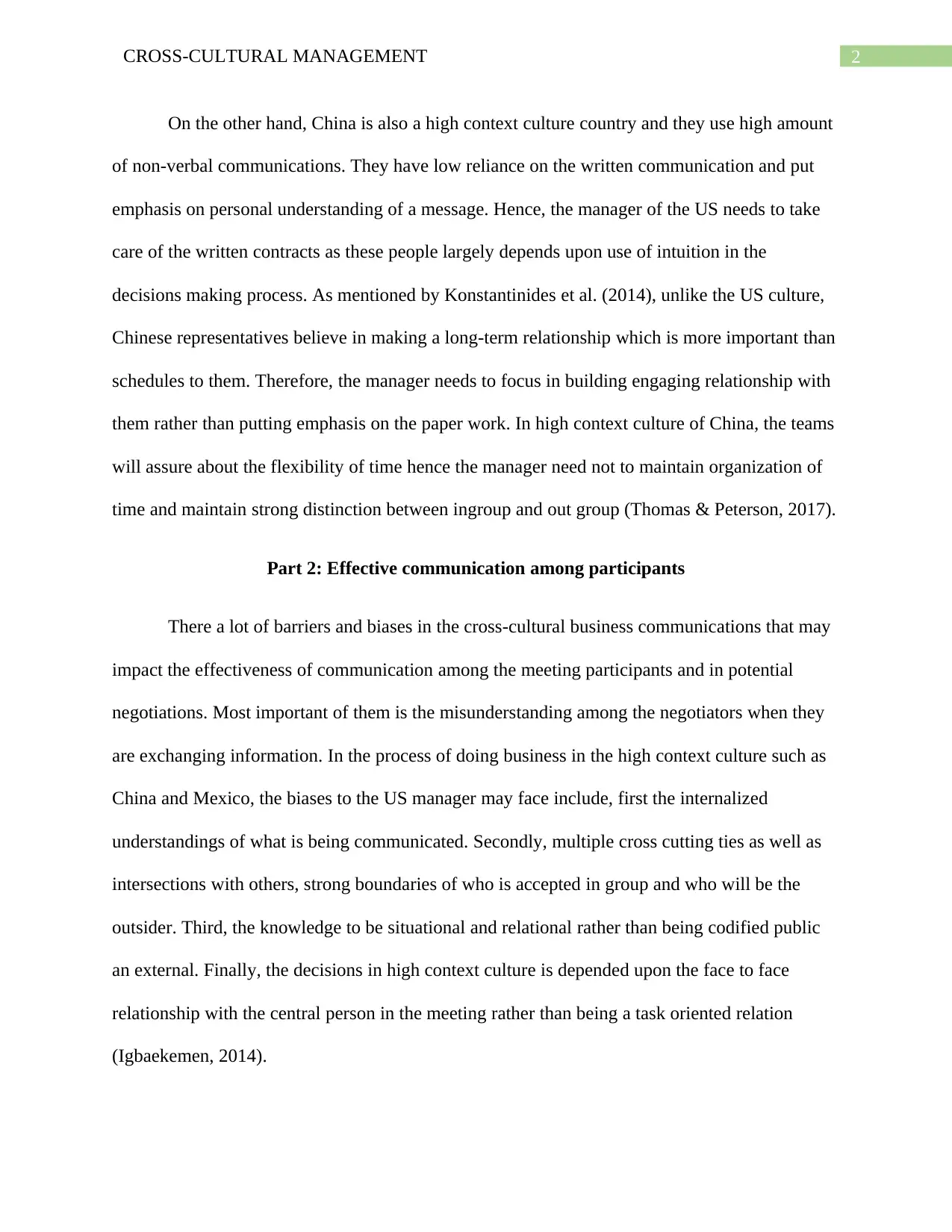
2CROSS-CULTURAL MANAGEMENT
On the other hand, China is also a high context culture country and they use high amount
of non-verbal communications. They have low reliance on the written communication and put
emphasis on personal understanding of a message. Hence, the manager of the US needs to take
care of the written contracts as these people largely depends upon use of intuition in the
decisions making process. As mentioned by Konstantinides et al. (2014), unlike the US culture,
Chinese representatives believe in making a long-term relationship which is more important than
schedules to them. Therefore, the manager needs to focus in building engaging relationship with
them rather than putting emphasis on the paper work. In high context culture of China, the teams
will assure about the flexibility of time hence the manager need not to maintain organization of
time and maintain strong distinction between ingroup and out group (Thomas & Peterson, 2017).
Part 2: Effective communication among participants
There a lot of barriers and biases in the cross-cultural business communications that may
impact the effectiveness of communication among the meeting participants and in potential
negotiations. Most important of them is the misunderstanding among the negotiators when they
are exchanging information. In the process of doing business in the high context culture such as
China and Mexico, the biases to the US manager may face include, first the internalized
understandings of what is being communicated. Secondly, multiple cross cutting ties as well as
intersections with others, strong boundaries of who is accepted in group and who will be the
outsider. Third, the knowledge to be situational and relational rather than being codified public
an external. Finally, the decisions in high context culture is depended upon the face to face
relationship with the central person in the meeting rather than being a task oriented relation
(Igbaekemen, 2014).
On the other hand, China is also a high context culture country and they use high amount
of non-verbal communications. They have low reliance on the written communication and put
emphasis on personal understanding of a message. Hence, the manager of the US needs to take
care of the written contracts as these people largely depends upon use of intuition in the
decisions making process. As mentioned by Konstantinides et al. (2014), unlike the US culture,
Chinese representatives believe in making a long-term relationship which is more important than
schedules to them. Therefore, the manager needs to focus in building engaging relationship with
them rather than putting emphasis on the paper work. In high context culture of China, the teams
will assure about the flexibility of time hence the manager need not to maintain organization of
time and maintain strong distinction between ingroup and out group (Thomas & Peterson, 2017).
Part 2: Effective communication among participants
There a lot of barriers and biases in the cross-cultural business communications that may
impact the effectiveness of communication among the meeting participants and in potential
negotiations. Most important of them is the misunderstanding among the negotiators when they
are exchanging information. In the process of doing business in the high context culture such as
China and Mexico, the biases to the US manager may face include, first the internalized
understandings of what is being communicated. Secondly, multiple cross cutting ties as well as
intersections with others, strong boundaries of who is accepted in group and who will be the
outsider. Third, the knowledge to be situational and relational rather than being codified public
an external. Finally, the decisions in high context culture is depended upon the face to face
relationship with the central person in the meeting rather than being a task oriented relation
(Igbaekemen, 2014).
⊘ This is a preview!⊘
Do you want full access?
Subscribe today to unlock all pages.

Trusted by 1+ million students worldwide
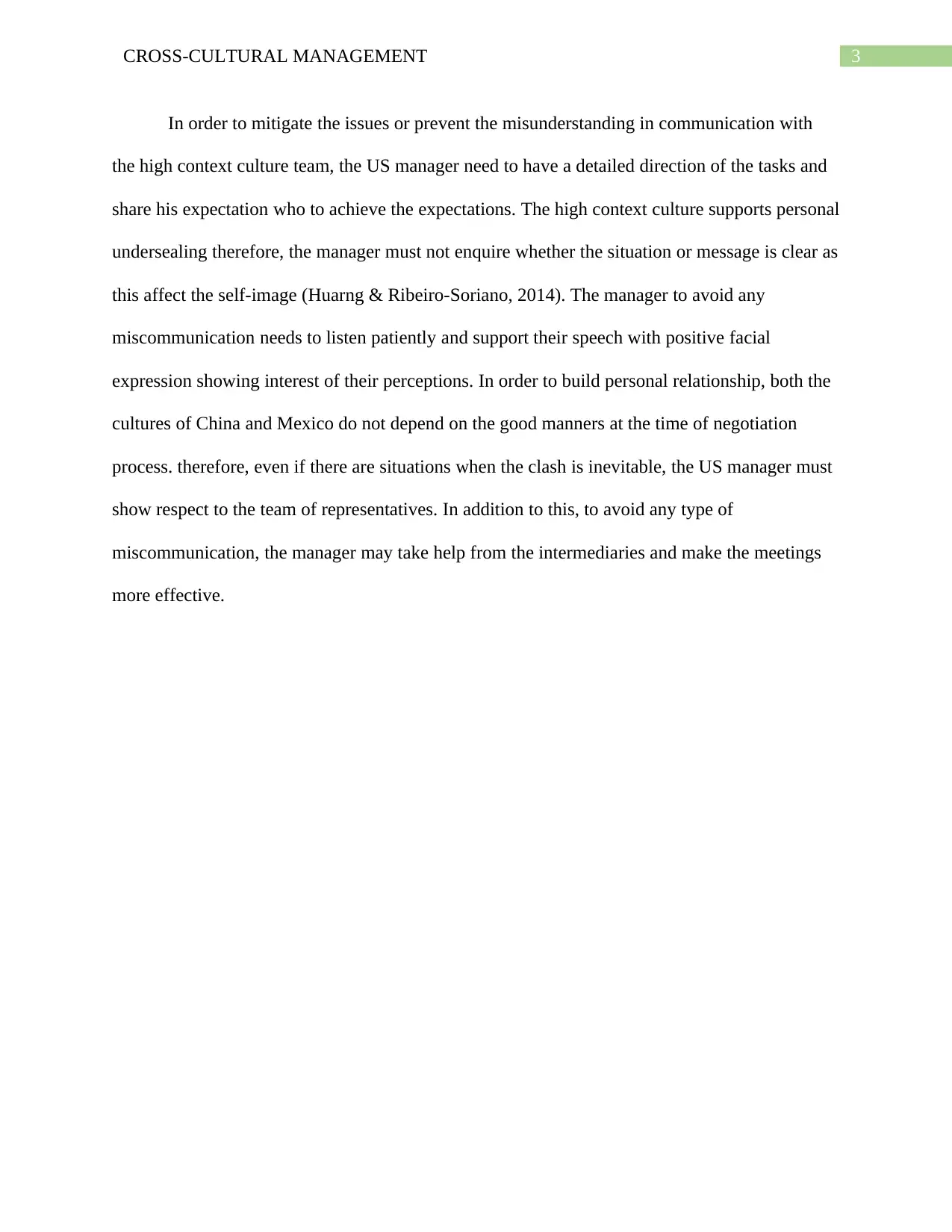
3CROSS-CULTURAL MANAGEMENT
In order to mitigate the issues or prevent the misunderstanding in communication with
the high context culture team, the US manager need to have a detailed direction of the tasks and
share his expectation who to achieve the expectations. The high context culture supports personal
undersealing therefore, the manager must not enquire whether the situation or message is clear as
this affect the self-image (Huarng & Ribeiro-Soriano, 2014). The manager to avoid any
miscommunication needs to listen patiently and support their speech with positive facial
expression showing interest of their perceptions. In order to build personal relationship, both the
cultures of China and Mexico do not depend on the good manners at the time of negotiation
process. therefore, even if there are situations when the clash is inevitable, the US manager must
show respect to the team of representatives. In addition to this, to avoid any type of
miscommunication, the manager may take help from the intermediaries and make the meetings
more effective.
In order to mitigate the issues or prevent the misunderstanding in communication with
the high context culture team, the US manager need to have a detailed direction of the tasks and
share his expectation who to achieve the expectations. The high context culture supports personal
undersealing therefore, the manager must not enquire whether the situation or message is clear as
this affect the self-image (Huarng & Ribeiro-Soriano, 2014). The manager to avoid any
miscommunication needs to listen patiently and support their speech with positive facial
expression showing interest of their perceptions. In order to build personal relationship, both the
cultures of China and Mexico do not depend on the good manners at the time of negotiation
process. therefore, even if there are situations when the clash is inevitable, the US manager must
show respect to the team of representatives. In addition to this, to avoid any type of
miscommunication, the manager may take help from the intermediaries and make the meetings
more effective.
Paraphrase This Document
Need a fresh take? Get an instant paraphrase of this document with our AI Paraphraser
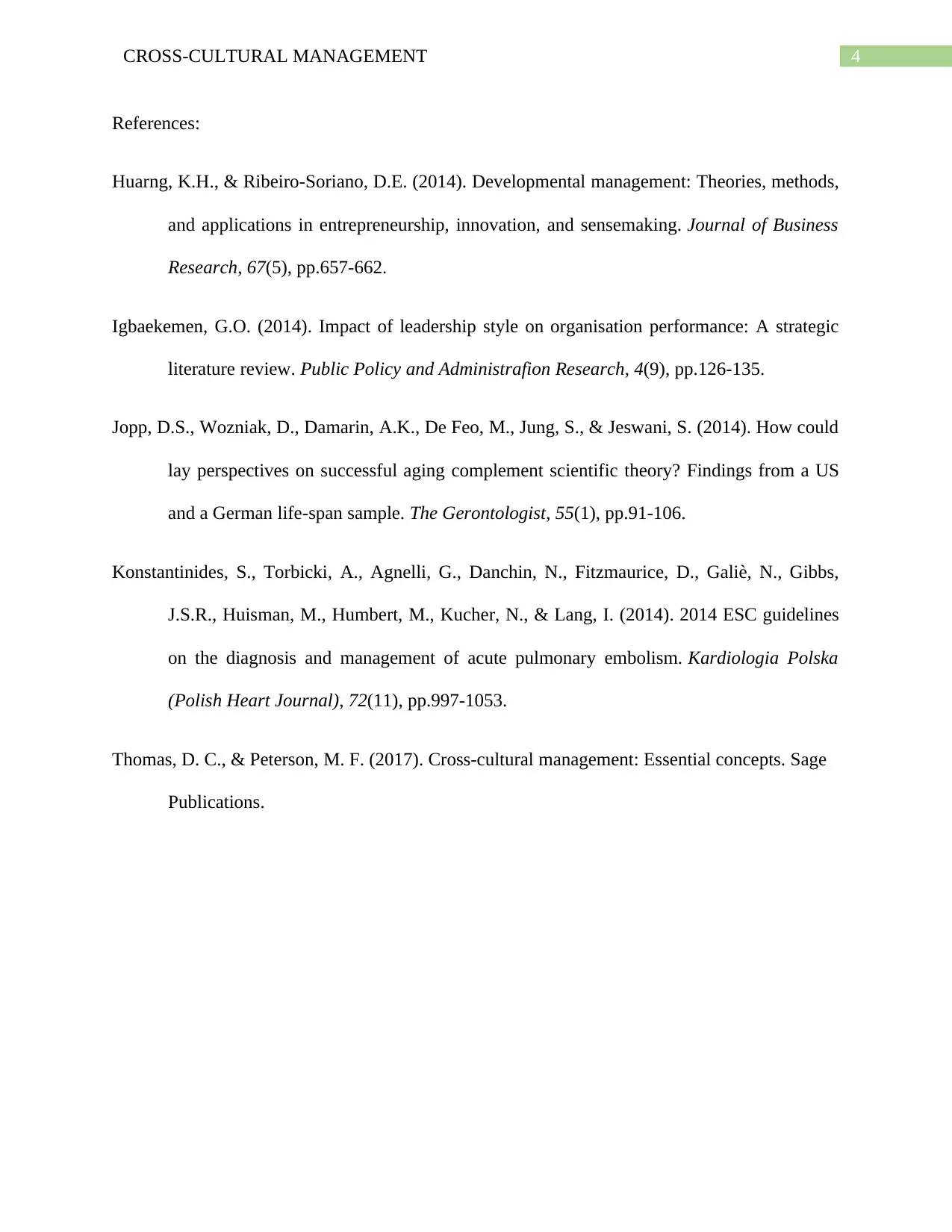
4CROSS-CULTURAL MANAGEMENT
References:
Huarng, K.H., & Ribeiro-Soriano, D.E. (2014). Developmental management: Theories, methods,
and applications in entrepreneurship, innovation, and sensemaking. Journal of Business
Research, 67(5), pp.657-662.
Igbaekemen, G.O. (2014). Impact of leadership style on organisation performance: A strategic
literature review. Public Policy and Administrafion Research, 4(9), pp.126-135.
Jopp, D.S., Wozniak, D., Damarin, A.K., De Feo, M., Jung, S., & Jeswani, S. (2014). How could
lay perspectives on successful aging complement scientific theory? Findings from a US
and a German life-span sample. The Gerontologist, 55(1), pp.91-106.
Konstantinides, S., Torbicki, A., Agnelli, G., Danchin, N., Fitzmaurice, D., Galiè, N., Gibbs,
J.S.R., Huisman, M., Humbert, M., Kucher, N., & Lang, I. (2014). 2014 ESC guidelines
on the diagnosis and management of acute pulmonary embolism. Kardiologia Polska
(Polish Heart Journal), 72(11), pp.997-1053.
Thomas, D. C., & Peterson, M. F. (2017). Cross-cultural management: Essential concepts. Sage
Publications.
References:
Huarng, K.H., & Ribeiro-Soriano, D.E. (2014). Developmental management: Theories, methods,
and applications in entrepreneurship, innovation, and sensemaking. Journal of Business
Research, 67(5), pp.657-662.
Igbaekemen, G.O. (2014). Impact of leadership style on organisation performance: A strategic
literature review. Public Policy and Administrafion Research, 4(9), pp.126-135.
Jopp, D.S., Wozniak, D., Damarin, A.K., De Feo, M., Jung, S., & Jeswani, S. (2014). How could
lay perspectives on successful aging complement scientific theory? Findings from a US
and a German life-span sample. The Gerontologist, 55(1), pp.91-106.
Konstantinides, S., Torbicki, A., Agnelli, G., Danchin, N., Fitzmaurice, D., Galiè, N., Gibbs,
J.S.R., Huisman, M., Humbert, M., Kucher, N., & Lang, I. (2014). 2014 ESC guidelines
on the diagnosis and management of acute pulmonary embolism. Kardiologia Polska
(Polish Heart Journal), 72(11), pp.997-1053.
Thomas, D. C., & Peterson, M. F. (2017). Cross-cultural management: Essential concepts. Sage
Publications.
1 out of 5
Related Documents
Your All-in-One AI-Powered Toolkit for Academic Success.
+13062052269
info@desklib.com
Available 24*7 on WhatsApp / Email
![[object Object]](/_next/static/media/star-bottom.7253800d.svg)
Unlock your academic potential
Copyright © 2020–2025 A2Z Services. All Rights Reserved. Developed and managed by ZUCOL.




